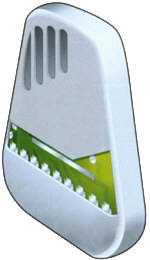Holographic Technology
Holodeck...
...walls can generate hob graphic images that appear to extend for an unlimited distance. Holograms can also be projected into space They can be augmented with force beams to simulate solid, tangible objects or with replicator technology to create actual solid matter such as foodstuffs.Holodeck matter can impersonate real matter even at the molecular level.Molecule-sized magnetic bubbles replace molecules in full- resolution holo-objects. The computer can manipulate them individually in three dimensions. The computer may use large magnetic bubbles to simulate surfaces and textures rather than create an object at the molecular level.
Computers can not duplicate the complexity of electron shell activity and atomic motions that determine biochemical activity in living creatures. This prevents replicators from duplicating life and resurrecting the dead. Advances in computer technology may allow this, permitting a person to live for ever in any chosen environment while interacting with real people and objects visiting the holodeck. On the other hand, a per son can he injured on the holodeck.
All foods eaten on the holodeck are replications. No other type of simulation would survive outside of the holodeck.
The holodeck includes a force field treadmill. Approaching a wall causes an instant shift away. The holodeck can change gravity in three dimensions, so occupants don't notice the change.
Any technology has limitations. "Reality gaps" can be come apparent.
The Voyager crew once tried to hook the holodeck power systems to the main power systems and blew out a conduit. This explains why the crew uses the holodeck despite the limitations on power supplies aboard the lost starship.
The Emergency Medical Hologram
The Voyager has the only holographic doctor. The Holodoc is an empty shell with nothing beneath the apparent surface to avoid wasting Computer power simulating unnecessary internal Organs.
Holodecks use "omnidirectional holographic diodes." The Voyager's sickbay is fitted with a system of OHDs that project an image of the Doctor. Each projects a complete image. Visible portions change as the Doctor moves, creating an illusion of fluid motion.
Magnetic containment fields allow the Doctor to interact with physical objects. These force fields move as the Doctor moves to create the appearance of solid matter. He can shut off the containment fields, allowing objects and people to pass through him.Similar OHDs and magnetic fields were added to other parts of the ship, allowing the Doctor to leave sickbay. The Doctor's first mission away from sickbay took place on the holodeck.
His cohesion can range from solid to in tangible. He appears human in other ways. He eats, drinks, and exhibits a dry sarcasm.
The Doctor possesses a data bank of medical information. He is slowly developing his own personality. The Doctor now possesses the emotional range of an average human crew member. He can become proud, caring, lonely, happy, indignant, annoyed, and angry. He even once confessed that he was anxious before going on his first "away" mission out of sickbay. The Doctor has begun to interact with other crew members in an intimate way. He has enjoyed two, brief, romantic relationships.
He now has sole control over his own on/off command. He not only doctors patients but also keeps records, maintains equipment, and performs other duties in sickbay.
The Holographic Emitter

The Emergency Medical Hologram onboard the U. S. S. Voyager NCC-74656 uses an autonomous, self-sustaining mobile holoemitter that was made in the 29th century. The tiny device can perform all the functions usually performed by the arrays of holoemitters that are built into the ship's sickbay and holodecks. Technologically it is far more advanced than anything developed in the 24th century by Starfleet, and the crew have only a very basic understanding of how it works.The mobile emitter is only a few centimeters in length, and is constructed from a smooth, gray metal. It has an independent power supply, and can store the entire EMH program and project the solid light hologram in almost any environment. This not only allows the EMH to move freely around the ship, but also allows him to leave it in order to accompany members of the crew on away missions. Although the holoemitter originated in the 29th century, the Doctor acquired it on a visit to the 20th century; it was one of several artifacts that had been appropriated by the entrepreneur Henry Starling when he found a crashed timeship. Starling down-loaded the Doctor from Voyager's computers and gave him the holoemitter to make him mobile. The holoemitter has a memory large enough to store more than one holographic program, but it appears that it can only project one hologram at a time. The visible interface consists of only a few controls, but they can be used to make adjustments to the Doctor's program. For example, when the crew were marooned on a Nyrian colony ship, B'Elanna Torres made adjustments to the holoemitter that effectively turned the Doctor into a tricorder. His optical sensors were reconfigured, increasing his optical resolution and allowing him to see energy signatures emitted from surrounding portals.
The holo-emitter has some weaknesses. Its ability to project and store holoprograms can be affected by energy surges and radiation, and it can be deacti-vated by a sharp blow. Since the holoemitter does not appear to have a safety backup, if the Doctor's program is endangered he returns to sickbay and down-loads himself into the ship's main computers. The process of downloading the program from one system to the other takes only a few seconds. The process also works in reverse if Voyagers computers are damaged, the Doctor can protect himself by downloading his program into the holo-emitter.
This information has been collected from various scources on the web. And various Trek magazines and books. --------------------------------------